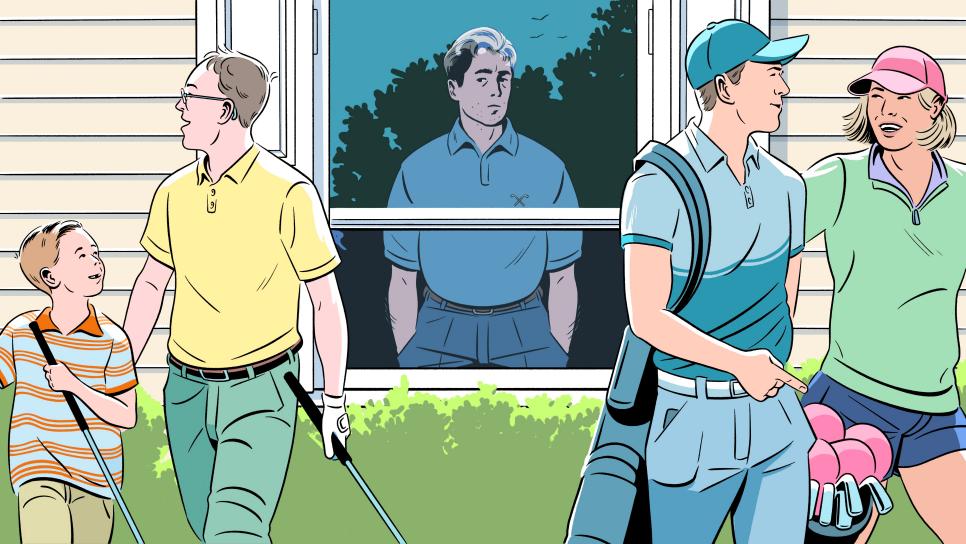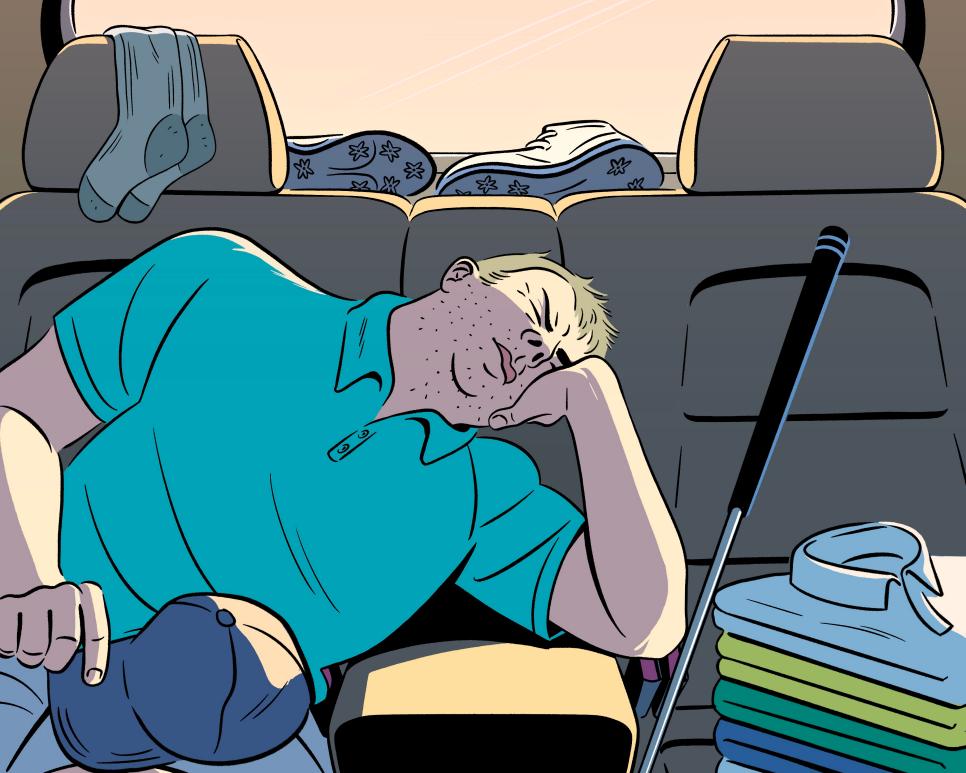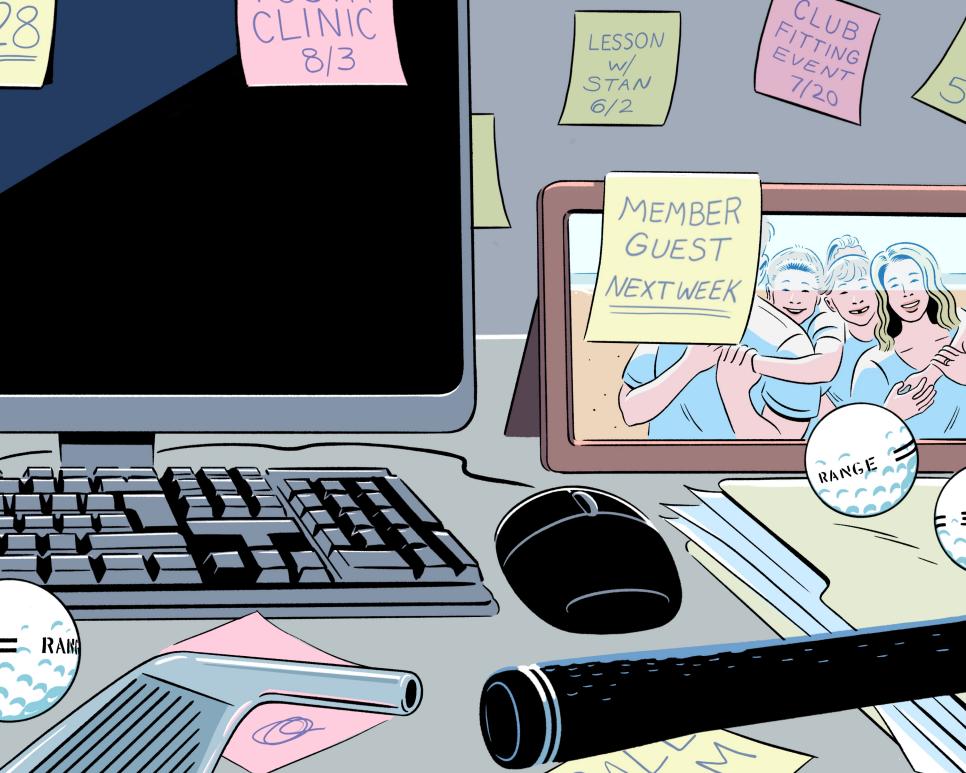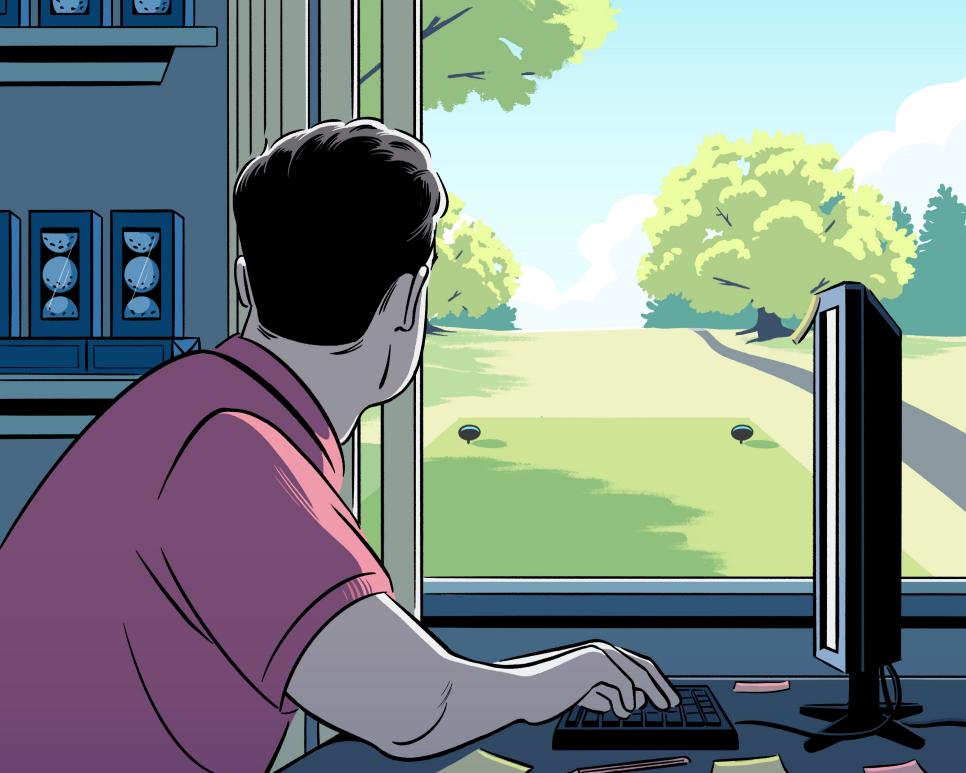Special Report
The Club Pro Crisis

"The last subject I want to talk about, and most importantly, is something we've discussed a lot this week. We've gone from a demand problem in terms of players to a supply problem. The lack of supply is hours in the day, lack of balance in our members' lives and a lack of pipeline of talent to replace our aging population … virtually everyone has been asked to raise the bar, to do more with the same, to work insane hours. It's absolutely unsustainable, and there's a crisis brewing for facilities that don't get in front of it. They simply won't be able to deliver the same level of service in the short-term, much less attract the next generation of talent. We have to shout this message from the rooftops, change the dynamic and restore work-life balance."
—Seth Waugh, PGA of America CEO, at the PGA annual meeting in November 2021
Editor’s Note: In order to avoid professional consequences, several sources in this story asked to remain anonymous. When a first name only is used, the name has been changed and geographical details have been generalized. When a first name and last name are used, this is the person's real name and story.
Thanks to his connections, Casey Kermes had forged what looked like the start of a brilliant career. After hurting his back playing college lacrosse, he joined a Professional Golf Management (PGM) program, landed his first internship in Ireland and spent the first four years of his post-college career bouncing between some of the most prominent courses in America as a seasonal assistant pro. Frequent travel was an expectation for ambitious assistants, but money was a problem—he wasn't even making enough to rent a shared apartment and would often stay in the spare bedroom of the head pro. At his breaking point, he landed a job as a full-time assistant in North Carolina, with the promise that he'd spend most of his time teaching. Instead, when he left the clubhouse at all, he found himself babysitting large groups of kids who didn't want to be there any more than he did.
At 26, he took stock of his career. He felt like "a glorified McDonald's checkout person," his golf game was dismal—he had played just five full rounds in two years—and he was working anywhere from 60 to 90 hours per week depending on the season. The concept of having a normal romantic relationship, much less a wife and kids, was a joke. And dealing with members could be a nightmare; he vividly remembers the day when he told a board member that her foursome couldn't start on the second hole, and she chewed him out and did it anyway. There was another board member in the group she skipped, and he marched into the golf shop to yell at Casey for letting it happen. Both members, incidentally, were millionaires. Casey was making $30,000.
He knew that the pay would go up when he became a head pro, but from what he could see, nothing else would change. He couldn't stop thinking of a head pro in the south, his one-time boss, who would get free NFL tickets from a member but feel too guilty and too afraid to take his son to the game and miss a Sunday at work.
"I was at the tipping point where you go from seasonal assistant to full-time assistant to head pro," Kermes said. "And I was looking at those jobs and thought, 'I don't actually want to do that. It still sucks. When does this not suck?' And I could never figure out when that was."
He quit before his 27th birthday. His only regret now is that he waited so long.
To almost everyone in his field, it looked like Gabriel had the dream job. He was the head pro at a famous northern club and had sacrificed time to get there—time with his wife and children. But over the course of his career, Gabriel's role shifted away from the parts of the job he loves— teaching and playing—to more about business administration. Technology facilitated the change; where once he could have headed south to decompress in the winter, now it was rare to go more than an hour without responding by phone or email to a member or one of his bosses. He watched his colleagues leave the game due to the lack of work-life balance, and if the industry already felt like having a seat on the Titanic, COVID-19 accelerated its disastrous course. While participation boomed, so did the demands on the time of the pros and assistants. Gabriel worked 85 hours per week in the summer and up to 50 hours in the winter, only to be told that he wasn't at the club enough.
His general manager once asked a seasonal assistant a loaded question: "What's with your generation and their work ethic?" The assistant, who was already putting in 50 hours a week, had an answer: Her generation put a high priority on mental health, and while career mattered, they wanted a life outside of work. And if they didn't rise as high, so be it. They'd enjoy life a lot more.
Gabriel had grown up with a different mindset. His path was to grind through his 20s and 30s, working as hard as necessary to reach the top. Once there, he thought he'd be able to breathe.
He couldn't breathe, and the day came when being at the top was no longer enough. His wife began to notice his unhappiness, and that made it harder to stomach his long absences. The pandemic ran him ragged, and he reached the point where he would have gladly taken less pay for a bit of downtime. It wasn't happening, so he left. Now he runs his own business and feels like he has an entirely new life.
"The reality is, for the clubs that don't change and the people who are sticking their head in the sand on this one, they're going to really get left by the wayside, because the labor pool is as tight as I've seen in my entire career."
—Paul Levy, former PGA of America president
After a source urged me to pursue this story, I sent a tweet asking pros and former pros to tell me their stories. The response was immediate and overwhelming, and accounts like Casey’s and Gabriel’s, and others that appear in this piece, represent a small but representative sample of those who reached out. The details were not a total surprise, but I didn't expect to find it all so heartbreaking. These were people who came into the industry with a vision for what their lives would be, had watched that vision grow dimmer over time and were now either holding on in the desperate hope that things would change or had been beaten down so thoroughly that they felt forced to quit.
To take showers or use the toilet, he had to drive to a rest stop on a nearby turnpike. Meanwhile, at the club, he felt like little more than a cashier, and at one point he worked 24 days in a row.
There were several recurring complaints in these conversations, from low pay to mistreatment to dissatisfaction with the nature of the work (not enough teaching, especially). One issue mentioned frequently was how simulators and other technology had erased even the short periods of downtime in the winter offseason, while others lamented that the head pro no longer owned the golf shop at most clubs, which eliminated a big revenue stream. These types of complaints, though, varied by person. Some pros made very good money, while others praised their members and bosses.
There was one complaint that they all shared, and that complaint was time. The message they needed me to understand was simple: There are many elements of this job that are great, and there are many others that are tolerable, but the lack of work-life balance is ruining our lives.
Johnny, 23, fell in love with golf because of the movie “Happy Gilmore.” He began his career working seasonally and ended up at a platinum club in Florida. He was excited, but things started on a negative note when his employee housing was so riddled with mold that it wasn't habitable. In Florida's crowded real-estate market, he didn't have enough money to rent his own place, and he was forced to couch surf or splurge on cheap short-term AirBnBs. At the end of every two weeks, he was out of money again, forced to sleep in his car at campgrounds and rest stops. Finally, he worked up the courage to tell his head pro. I'm basically homeless, he said, and I can't keep doing this.

The head pro told him that he better find a garage because they had big events coming up and if he quit he'd make sure he never worked at a top-tier club again. Feeling hopeless, Johnny capitulated. The only housing he could find was a run-down apartment with his friend, where he had to sneak in to make sure he wasn't seen by the landlord. Even the bathroom was under repair, and in order to take showers or use the toilet, he had to drive to a rest stop on a nearby turnpike. Meanwhile, at the club, he felt like little more than a cashier, and at one point he worked 24 days in a row.
"I used to be so energetic, but now I just feel tired all the time," he said. "Even on my days off, all I want to do is sleep all day. But I don't sleep well, because I'm always worried. The last thing I want to do is go play golf. … It's hard enough for me to get up and do my laundry."
Stuart, now in his 40s and a director of golf at a public course, remembered a dinner he attended with a few older golf pros when he was starting his career. One of them paused the conversation and asked for a show of hands: Who would encourage their own kids to get into the business?
Not a single hand rose.
"People have this weird idea that it's just cool hanging out at the golf course, that you're privileged to be here, why wouldn't you want to be here 24/7?" he said. "There's just no respect for our personal time. I do want a life outside this place, you know?"
Anecdotal evidence for the work-life crisis is easy to come by, but the nature of the disconnected network of golf clubs means that hard data isn't always readily available. It is impossible, for instance, to find out the number of hours an average pro or assistant works each week. But the numbers that do exist confirm the existence of a problem.
Bob Bruns is the director of the Professional Golf Management (PGM) program at Methodist University, one of 18 extant PGM programs in the U.S. (Clemson University recently decided to shut down its program after the last class graduates, so that number will be 17 within three years). When Bruns took the job in 2006, his incoming class consisted of more than 100 students. Today, that number is 38. He told me that in 2004, a benchmark year for programs like his, there were more than 9,700 students in PGM schools or associate programs working toward PGA membership. In 2022, according to data released by the PGA of America, the total has fallen to less than 5,000, a decline of 49.3 percent in less than 20 years. Across his program in 2021-22, Bruns placed around 100 students in internships, but had 750 requests for those interns. When he spoke with a head pro at a top-100 club recently, the pro told him that in the past, when someone needed an assistant, he could pull out a folder with résumés of applicants who would be ready to move at a moment's notice. Today, that folder is empty.
The question to the group: Who would encourage their own kids to get into the business? Not a single hand rose.
Since 2018, the number of assistant professionals nationwide has fallen from 4,037 to 3,621, while the number of head professionals has gone from 5,428 to 4,899—in both cases, a drop of around 10 percent in just four years. That number looks even more alarming in the face of a participation boom; in 2020, despite many course closures at the start of the pandemic, the National Golf Foundation reported a 14-percent increase in rounds played, the biggest jump by far since 1997. In 2021, that number rose again, by around 5 percent. As Waugh noted at the PGA of America's annual meeting last fall, this increase is putting an even greater burden on today's working pros.
At the same time, there has been a decrease in applicants for all job positions since the start of the pandemic, a fact confirmed by the PGA of America and the pros who highlighted the difficulty in finding good hires—or in some cases any hires. Again and again, they pointed me to the overflowing job boards on the PGA of America's section websites. One head pro said that just three years ago, when he had an assistant's job come open, he had 20 applicants. When the same job became available again last year, he had four. He tried to offer the job to one of his finalists from three years earlier, with a salary that was now $17,000 higher, but he was turned down—the former applicant worked 36 hours a week at CVS and couldn't imagine doing more.
Many of the pros I talked to referred to this as a “brain drain”—the loss not only of raw numbers of workers, but of the kind of quality assistants they’d want at their courses. Statistics also support the idea of an exodus; among professionals elected to PGA membership from 2009 through 2018, 27 percent are no longer members, and while there is no data on how many of the remaining 73 percent still work as pros, it's possible to maintain PGA membership without being a working pro, which means the real number of drop-outs is likely higher.
For men like Bruns, the difficult situation puts a premium on recruiting. His job has changed drastically, to the point where he now meets with every student and every set of parents who make a campus visit, and employs a full-time recruiter just for his program.
The story is the same at the PGA of America, an organization that has become hyper-focused on recruiting. In conversations with Suzy Whaley, the president of the PGA of America from 2018 to 2020, and Jim Richerson, the current president, both emphasized the steps the organization is taking to increase membership. The recruitment drive began in earnest around 2015, according to Whaley, in response to declining numbers across the nation. They began to recruit at the college golf level, including club teams, and even delved into the high school ranks through NextGen Golf and the PGA Jr. League. The PGA Hope program has opened the door to recruiting veterans, and along with these partnerships, the PGA of America now employs four full-time recruiters with no other mandate than to beat back the tide.

These efforts are robust, but as the numbers show, they haven't stemmed the overall decline. Even if they did, recruitment is a temporary solution. If the job itself is still considered undesirable from a quality-of-life standpoint, adding more people only plugs a hole in a leaky ship. The unanswered question is, how do you fix the big problem? Or, more pessimistically, can it be fixed?
The obvious impediment to progress on a large scale is that golf courses are owned and managed by individual entities, some public and some private, and while the PGA of America is the overarching organization to which professionals belong, the PGA of America is not the same as a labor union. While a labor union could theoretically fight for quality of life changes through negotiations or a more drastic collective action like a strike, the PGA's influence on individual golf courses is indirect at best.
On one hand, it was abundantly clear in conversations with the PGA leaders that they recognize the problem, understand the threat it poses to recreational golf and are taking serious steps to address it on both an individual and industry-wide level.
"We're a people business, and we're a service business," Richerson said. "You need to really be there to develop those relationships, and that has put a strain on the PGA professional. At our last meeting in November, and subsequent board meetings, we've talked a lot about the importance of addressing those challenges in the workforce."
On the other hand, it was also clear that their power to force change is fundamentally limited. If the obvious solution to this problem lies with clubs hiring more people so that the obligations of each individual aren't so oppressive, the equally obvious obstacle is that those same clubs have become used to pros who work long hours and can be reluctant to spend the money necessary to hire more personnel. That's equally true for public and private courses, and from pros around the country, it was more common to hear stories of boards cutting positions rather than adding them.
The good news is that pay has gone up. From 2019 to 2021, the average compensation for a full-time head golf professional rose by 8 percent, to $101,981, while the pay for full-time assistant professionals increased 16 percent, to $53,786. (Despite this development, Waugh acknowledged last November that the increase wasn't adequate.) Even with rising pay, it's important to remember the declining numbers of professionals, which highlights a truth that was repeated to me again and again: this is primarily a work-life balance problem, not a money problem.
The PGA has taken what steps it can to improve working conditions. Their career services department has grown to include more than 20 full-time career consultants who not only help pros seeking new jobs, but also work closely with the clubs themselves and their boards. If there's a position to be filled, the PGA of America can throw its hat in the ring as a search firm, and in the process encourage clubs to increase pay and consider adding new positions. For struggling pros, the Member Assistance Program, which costs just $5 annually, offers a variety of quality-of-life services, including counseling on mental health, relationship, and addiction issues.
Dan Simpson has been the head pro at Minneapolis Golf Club since 1990, and at age 54, he belongs to a generation that continued to work long, hard hours even after landing a coveted head pro job. "It's hard," he said. "I have three kids, and they're all in college, but I mean, the things I missed in the summer ..." Here, he trailed off before finishing. "I missed a lot."
Last summer, Simpson worked every day between April 1 and Sept. 25. That was nothing new for him, and in fact when he married his wife more than two decades ago, he told her that if she wanted to move forward, she'd have to understand and accept that he'd be gone for almost six months of the year.
"But after all these years, it kind of wore on her," he said. "And I don't blame her, you know?"
He still loves his job, loves the game and loves the staff and the members at his course. He can't imagine doing anything else with his life. But two years ago, he and his wife divorced.
Even today, when Derek's wife hears the words "the club," it leaves a bitter taste in her mouth. "The club" was the place that meant Derek had to miss dance recitals, gymnastics, T-ball games and school plays because he was working 80 hours a week as head pro in the northwest, earning $20,000 less than his predecessor. He has fond memories of his time—he got to play Pebble, and he and his wife took a European trip together—but mostly it was a slow decline as his dream gave way to a very different reality. His favorite week every year came during an annual vacation to a remote area without cell phone coverage, because then he could truly check out and escape the stress of the job that never went away.
He began to experience constant anxiety at work. He felt damned one way or another; if he spent too much time outside with lessons, he'd be chastised for inventory work that didn't get done. If he spent too much time inside, there would be complaints that he wasn't showing his face. He was diagnosed with depression, and when the board changed over and he learned that one of the members was intent on getting him fired, he knew it was time to go. Today, he's "tenfold" happier, but it's the sacrifices he made, for what feels like nothing, that eat at him the most.
"Those days are gone for a lot of these younger pros," he said. "They want to live life, too, and you can't really blame them. Maybe people are smarter now."
While it's true that COVID has made the demands on pros and assistant pros incrementally worse, this problem didn't begin with the pandemic. In fact, it has been going on for a very long time, which leads to another question: What has changed? Why is this coming to the forefront now? According to almost everyone I spoke to who serves in a leadership capacity anywhere in the industry, part of the answer is a generational mindset shift.
Richerson, who along with his PGA presidency is the General Manager at historic Riviera Country Club outside Los Angeles, has spent his career in golf management, and the perspective he sees in young workers today isn't one he recognizes from his own past.

"Thirty years ago when I was coming out of college, I didn't necessarily do it so much as a job, but as something I was passionate about," he said. "Now, I just think individuals come in for different reasons. They look at their future, their careers a bit differently. Some are willing to change industries—not just jobs, but they're willing to change industries every year or two years or three years. I don't think that's something that was common in individuals of my age."
"Young people are hoppers, right?" said Whaley, who works now as the Director of Instruction for the Country Club at Mirasol in Florida after serving as the PGA of America’s first female president. "They want a five-day work week, they want to go on vacation with their family, they want weekends off. And certainly if you get into our business, that's not the case. So you have a standard of what a traditional golf professional is used to, in terms of working hours, versus a younger generation that just says, 'no.'"
It can be easy to read some of these remarks as subtly critical, but many of the pros who came up the old way see the new generation's approach as refreshing. Simpson, the head pro at Minneapolis Golf Club, understands and even envies their perspective, even as someone who never expected anything but long hours in his own job.
"Those days are gone for a lot of these younger pros," he said. "They want to live life, too, and you can't really blame them. Maybe people are smarter now."
Aaron sees the writing on the wall, and that's why he's going back to school and planning to leave the golf industry. He's 31, and as an underpaid assistant on the east coast, a future of jumping from club to club chasing a head pro job seems less appealing all the time. His base salary is $32,000 per year (that's after a recent 10-percent raise), and the fact that he's salaried means there's no overtime when he works 12-hour days in the summer. He thinks of his life like the film “Groundhog Day”—it's the same thing every day, year after year, and he can't even go out on weekends with his fiancée or his friends. He suffers from negative thoughts, and during one of his recent reviews, he was told that the members wanted to see him smile more. That pissed him off, and he could barely suppress the first response that came into his head:
"Why would I smile?"
Steve Scott is perhaps best known as the man who stood in Tiger Woods' way in 1996 in the U.S. Amateur final, which Tiger won in 38 holes in part because Scott reminded him to move his marker back before a crucial late putt. Scott continued to play professionally until 2005, and afterward, when he pursued the club-pro path, his reputation was enough to ensure a quick ascent. Before long, he was head pro at Paramount Golf Club in New York, where he stayed until 2017. Scott had what many would consider an ideal situation. He was paid well and had a 5,000-square-foot house on the course. Still, it wasn't uncommon for him to work 80 hours a week in the busy seasons, and the service aspect of the job—appealing to members, and inevitably disappointing and being attacked by some of them—began to take its toll. He found that his patience was being tried daily, and while he's a relentlessly positive person, he could feel the burnout coming. Nor did his own skill make his job any easier.
"The ability to play well really doesn't matter much anymore," he said, laughing. "It matters in some of the clubs that are more traditional, but most other places you might as well just be a shop clerk at Macy's."
After nine years of being "bombarded and hounded," he'd had enough, and left the industry. Today, he runs the Silver Club Golfing Society, which stages tournaments nationwide for amateur golfers. He's able to work from home, and like many of the pros I spoke with, he can vividly remember the moment when he knew he'd made the right choice. It was a Memorial Day weekend, and he spent the holiday at the pool with his wife and two kids. That would be an ordinary event for many families, but for Scott, it was almost inexplicably special—he hadn't been able to do something like that for years.
The battle to educate clubs about the need for fundamental change might be the most critical fight of all, and Tom Wallace wages that war on the front lines. He spent his career in golf management—his résumé includes 10 years as General Manager at Oakmont Country Club—before moving to his current role in 2014 as a partner at the executive search firm Kopplin, Kuebler and Wallace. A big part of Wallace's job is helping clubs fill positions like director of golf and general manager and head professional, and in the process of finding the ideal candidate, he works tirelessly to convince the boards to consider quality of life. (His firm is a part of the Club Leadership Alliance, a group that educates clubs about these exact issues.) Like the PGA of America, who are technically his competitors, Wallace understands that these interactions with clubs are essential to chipping away at the problem of work-life balance—a gradual process of persuasion he calls "constant gentle pressure."
"Expectations have to change," he said. "We've spent a lot of time educating the search committees and these club boards, that these new club pros, they're not going to be there seven days a week, morning, noon and night. No one's going to work like that anymore. The industry as a whole has to make an effort. Clubs and facilities have to start to budget for the extra people you're going to need. They've got to offer a better quality of life to these young people."
If the obvious challenge is that hiring more staff means allocating more budget and potentially increasing members' dues, the persuasion has to appeal on a financial level. His pitch to them is that this isn't just a moral or empathetic choice—it's good business, too.
"You're going to get a better product," he said. "You're going to get a better director of golf, a better head pro, if they're able to spend time with their families and be home and be rested."
He sees a stark divide between the progressive clubs who are already taking steps to ensure the health and general wellbeing of their staff, and those that are not. The consequences of failing to be on the right side of that divide will be steep.
"It will continue to draw a line between those that can afford to be an employer of choice, meaning that they're not just paying well, but just as important, being able to give people their quality of life," he said, "and those that cannot."
In other words, if a club take these steps, and continues to adhere to the old model, the labor shortage will ensure that they can't land the best candidates. In turn, the ones they hire will either leave for greener pastures or be miserable in their jobs, which will harm the member experience and, inevitably, the bottom line of the club itself. If you're not "an employer of choice," your business model is about to get very difficult.
Kelly Williams, the 42-year-old club manager and former head pro at Greenbrier Golf and Country Club in Lexington, Ky., is determined to make his club an employer of choice. That’s no surprise; when it comes to quality of life, he’s taken on a role akin to a movement crusader. He served on the PGA Board of Directors until 2019, and ran for secretary of the PGA of America in 2020—a position that feeds into the presidency. Work-life balance was the major tenet of his platform, and though he began his campaign before COVID hit, it became even more poignant afterward.
As someone who once worked 80 hours per week as a head pro, the pandemic has allowed him to put his money where his mouth is, and Greenbrier is a case study for how the strain of the pandemic on golf pros can be turned to an advantage. The increase in rounds played gave Williams more freedom in his budget and allowed the club to make two major moves. First, they formed a partnership with a group of local instructors to reduce the burden on their own staff. Second, they transitioned to an increasingly common model: a head pro and a director of golf.
To Williams, this kind of flexibility on the club level has presented pros with a critical opportunity, and one that they must seize. "We're in this paradigm shift, where that old school is phasing out and the new school are becoming the club members and board members," he said. "A shift in expectations is as possible as it's ever been, and I believe it's the responsibility of the PGA members to speak for themselves in that board room when they're negotiating their contracts."
What Williams sees now is something novel for golf professionals: leverage. The declining labor pool and the scores of open positions don't just create opportunities on the individual level—they give pros and assistant pros a chance to redefine the job entirely. Another former pro I spoke to made this same point more bluntly.
"If pros don't stand up right now and say, 'No, we're not doing that,' they never will," he said. "There has never been a stronger job market. If you're a good golf professional who knows how to market yourself a little bit, there is no reason for you to stand back and take that crap anymore."
One of Williams' favorite moments came after his campaign was over, when he received a text from a longtime pro in his late 50s who had heard him speak. For the first time in his life, that pro had negotiated with his club for four weeks of vacation and was going to take a week in the middle of June for a beach vacation with his family. Williams empowered him, and his hope is that the example will be followed by other pros until it becomes commonplace.
On the other hand, his vision of a future mired in the status quo is dire—a golf industry full of clock-in, clock-out employees with no knowledge or passion for the game, and a sport that withers on the vine. He knows a hospitality industry like golf will never reach a model where employees work three 12-hour shifts each week, but he also knows that if they can't adapt and meet in the middle, a collapse is coming.
Williams lost his campaign. Ironically, one of the reasons some gave for voting against him was that he had a young family, and that the travel and responsibility that come from being the secretary, vice president and president of the PGA of America over six years would affect—yes—his work-life balance.
Despite the loss, Williams feels that he achieved something by bringing the issue to light and that attitudes are changing, if slowly. As our conversation ended, he had a final message that he delivered with a preacher's conviction.
"If you can do anything through this article," he said, "it's to write to the people who own and operate clubs and facilities and say, 'Take a look at what these people are doing for you. Make sure you're encouraging them to take time away so they can be at their best when they're present.'"
Williams knows too well that the future comes down to this. The educators can educate, the PGA of America can advocate, and the pros can fight for themselves in a patchwork substitute for collective action, but the final choice falls to the clubs.
As the crisis deepens, and the clamor grows louder, it's no longer possible for them to pretend they don't hear. The question is, will they listen?




